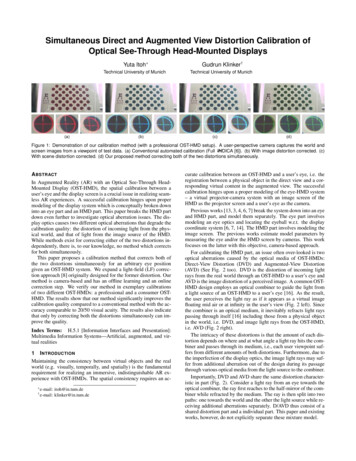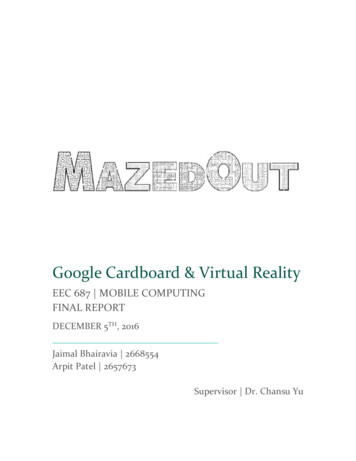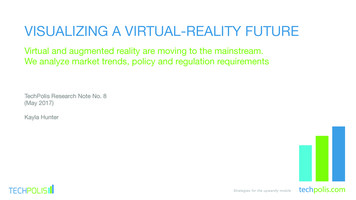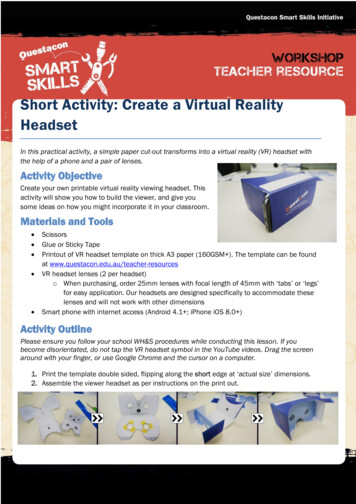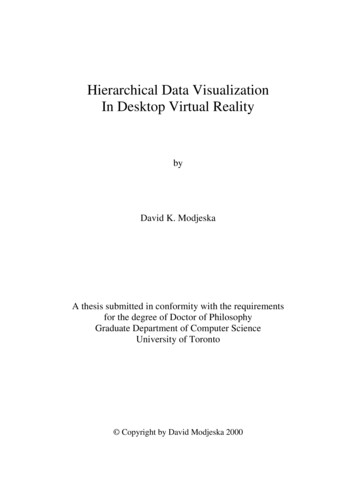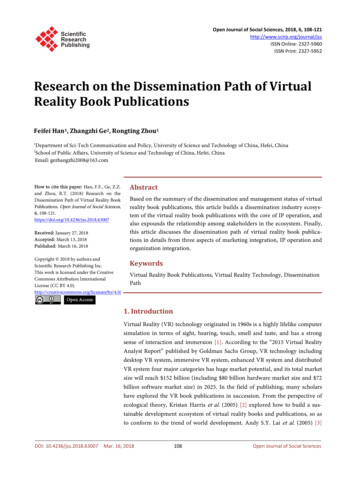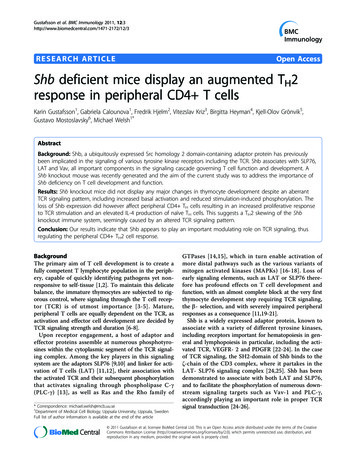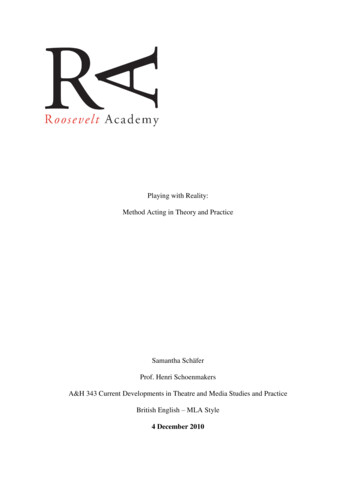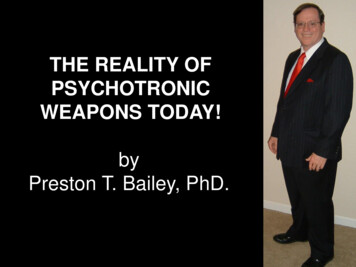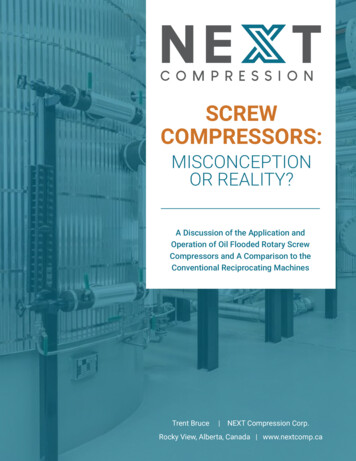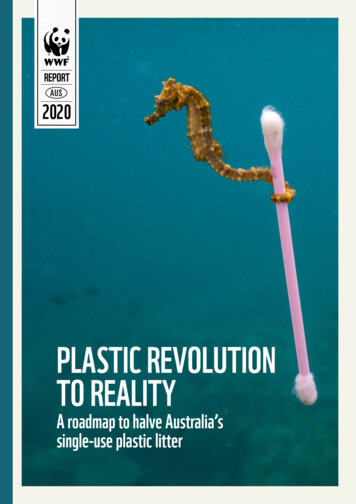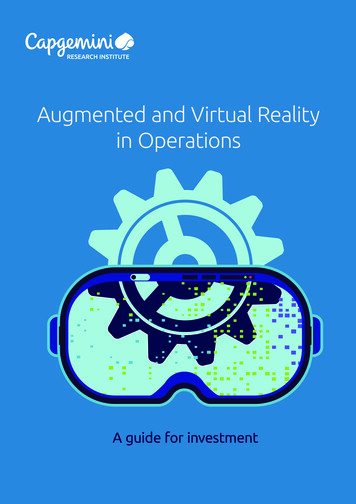
Transcription
Augmented and Virtual Realityin OperationsA guide for investment
IntroductionAugmented Reality and Virtual Reality (AR/VR) are not new,but recent advances in computational power, storage, graphicsprocessing, and high-resolution displays have helped overcomesome of the constraints that have stood in the way of thewidespread use of these immersive technologies. Globalspending on AR/VR is now expected to reach 17.8 billion in2018, an increase of nearly 95% over the 9.1 billion estimatefor 2017.1Given this impetus, we wanted to understand more about thecurrent state of play with AR/VR in the enterprise. We surveyedexecutives at 700 companies, including 600 companies whoare either experimenting with or implementing AR/VR; spokewith AR/VR-focused leadership at global companies, start-ups,and vendors; and analyzed over 35 use cases, with a particularfocus on: The use of AR/VR for internal industrial company operations,including, but not limited to, design, engineering, andfield services The automotive, utility, and discrete manufacturing sectors.This research focuses on organizations that have initiatedtheir AR/VR journey, whether by experimentation orimplementation, and aims to answer a number of questions: How is AR/VR being used today? Where should organizations invest – what are the use casesthat generate the most value? How can companies either begin or evolve their initiatives?Outside of this report, terms you will commonly find whenreading about AR/VR are mixed reality, hybrid reality, ormerged reality in which both the physical and the virtualor digital realities coexist or even merge. In this report, wedistinguish between AR and VR and use the collective “AR/VR”interchangeably with “immersive technology.”Additionally, although applications for immersive technologyare relevant in other parts of an organization’s value chain(sales, customer experience, etc.), for the purposes of thisresearch, we focus on the applications and benefits specificallyin business operations and field services.2Augmented and Virtual Reality in Operations: A guide for investment
Immersive technology has arrived,with AR the more widely practicedBoeing has used augmented reality to provide technicianswith instructions for airplane wiring schematics in their fieldof view, allowing them to be hands-free. This reduces wiringproduction time by 25%, increases productivity by 40%, andeliminates error rates.2Boeing's use of augmentedreality for technicians hasincreased productivity by40% and reduced wiringproduction time by 25%.Ford, on the other hand, uses virtual reality to increasehuman productivity and safety on the assembly line. Virtualreality identifies human movement captured through bodymotion sensors during equipment assembly with the goalof re-engineering movement to decrease risk of injury andincrease productivity. This has resulted in a 70% drop inemployee injuries and 90% reduction in ergonomic issues.3Fieldworkers at Toms River Municipal Utilities Authority(TRMUA), a New Jersey utility, use virtual and augmentedreality to see concealed utilities such as water, gas, electric,and sanitary and storm water sewer utility features. Thisconcept of “seeing through the ground” is possible throughan application that processes data from the geographicinformation system (GIS) that the Microsoft HoloLensultimately turns into a holographic projection of undergroundutility features based on the user’s location and orientation.This innovation increases the productivity of the fieldworkforce on a daily basis and more so under emergencysituations such as fire or flooding.4These examples illustrate how organizations are movingbeyond the hypothetical to pragmatic use. In previous years,organizations focused primarily on educating themselvesabout the technology. Just three years ago, “Companies werewondering ‘what can AR/VR do?’ and ‘where can it be used?’”says Dr. John Ahmet Erkoyunco from Cranfield University inthe UK. The technology has since come a long way. Per ourconversations with AR/VR software providers, the concernstoday are more about ROI and the rate at which software canbe developed.3
What is Augmented Reality and Virtual Reality?To start with, it is important to distinguish between the two technologies:Augmented Reality (AR)Virtual Reality (VR)A digital layer is superimposed on the physical world,integrating the physical, real environment with virtualdetails to enhance or “augment” the real-worldexperience. Experienced with: Smartphones, tablets,smart glasses and other head-mounted displays.Boeing’s technicians use ARinstructions for airplane wiringschematics in their field of view,allowing them to be hands-free.Fieldworkers at Toms RiverMunicipal Utilities Authority(TRMUA), a New Jersey Utility,use AR and VR glasses to seeconcealed utilities lines underthe streets in real-time.At Ford, VR is used to capturehuman movement duringequipment assembly throughmotion sensors to re-engineermovement to decrease risk ofinjury and increase productivity.Creates an interactive, completely digitalenvironment that provides a fully enclosed,synthetic experience incorporating auditoryand visual feedback, experienced often throughthe use of a head-mounted device (HMD).Benefits:Reduced wiringproduction time by orationBenefits:70%Source: Company websites and media articles4Increasedproductivity byAugmented and Virtual Reality in Operations: A guide for investmentDrop inemployee injuriesReduction in90% ergonomic issues
optionRate:27%Superimpose step bystep instructionsEarly design of conceptfully created in VRVirtual walk throughof the siteBoeing technicians workwith AR instructions forairplane wiringschematics in their fieldof view allowingtechnician to behands-free. This cutswiring production time by25% and reduced errorrates to zero.BMW engineers anddesigners use VR to testhow various componentsof a car look whenassembled withoutphysical prototyping. Thisbrings down the cost ofthe engineering processsignificantly.At Pacific Gas andElectric (PG&E), VR andplant data is used toprovide a quicker andsafer way for workers toinspect equipment,lowering the risk oftechnicians getting hurt.Visualize equipment inproduction environmentto see final productVR is used at Airbus tointegrate digitalmock-ups into productionenvironments, givingassembly workers accessto complete 3D modelsof the aircraft underproduction, reducingtime required to inspectby 86%.AdoptionRate:27%Remote collaborationDesigners at Fordcollaborate with eachother across vastgeographic distances tovirtually tour a new vehiclewith the engineering team.This avoids incurring travelcosts.Augmented Reality (AR)RemoteAssistanceStep-by-step instructions while performinga manual taskRemote assistance for support and guidanceVirtual Reality (VR)Equipment design discussion in the virtual worldEmployee using headsets for virtual training5
When will AR/VR become mainstream in your organization?Companies are split on when the technology will become mainstream: 46% within the next three years 53% after three years (see Figure 1).“The impact will not only improve in the next one to three years, but it will also become standard in theautomotive business,” says Frantisek Zapletal, Volkswagen IT.Figure 1. When will AR/VR become mainstream in your organization?Average 46%Average 53%41%38%37%34%16%14%9%7%Less than 1 year3-5 years1-3 yearsARMore than 5 yearsVRSource: Capgemini Research Institute, Augmented and Virtual Reality Survey; May-June 2018, N 603 organizations that areexploring and implementing Augmented Reality and Virtual RealityAR seen as more relevant and widelyimplemented compared to VREven though the use of VR in applications such as collaborativeproduct design can be highly impactful, we found that 66%of organizations believe AR to be more applicable to themthan VR. This could reflect the fact that while AR can alter our6day-to-day interactions with digital machines and systems,VR enhances individual immersive experience by isolatingthe user from the real world. Paul Travers, the CEO of Vuzix,a multinational firm that sells AR/VR wearable technology,agrees. He says that although VR will be big, there arelimitations to what you can do when isolated from the realworld.5Augmented and Virtual Reality in Operations: A guide for investment
By connecting the digital world to the real world, AR supportsa number of breakthrough use cases.6 These involve deliveringtext- and image-based content to workers performing manualtasks and access to real-time remote help from experts on awearable or handheld device. As a result, as Figure 2 shows,more organizations are implementing AR (45%) than VR (36%).Commenting on the applicability of VR relative to AR, “ VR isn’ttoo relevant for us, although we could use it to train peoplewho go to the substations, though there are less complicatedmeans,” says Antti Aarnio, head of Digital Services at Fingrid,a Finnish electricity transmission grid operator. “Especially inour industry, once it passes safety standards, AR could provideadded value for our employees in high-risk situations – forexample, being able to tell if a piece of equipment is underhigh voltage or high temperature.”Companies in the US, China, and Francecurrently lead the implementation raceThe US, in addition to having the most AR implementers(59%), is also expected to be the largest AR/VR spender in2018, at 6.4 billion (see Figure 3).7 Alternatively, the Chinesegovernment and Chinese companies have launched concertedefforts to become leaders in virtual and augmented realitythrough focused research and development efforts, directinvestment, and building human capital.8 France’s marketposition in this space is illustrated by its leadership in VRdevelopment across continental Europe, according to theVenture Reality Fund, a Silicon Valley-based venture capitalfirm focused on early state investments in AR/VR.9Figure 2. Out of companies deploying AR/VR, implementation levels by organization category45%36%64%ARVR55%Out of companies deploying AR, 55% areexperimenting and 45% are implementingExperimentersOut of companies deploying VR, 64% areexperimenting and 36% are implementingImplementersSource: Capgemini Research Institute, Augmented and Virtual Reality Survey; May-June 2018, N 603 organizations that are exploring andimplementing Augmented Reality and Virtual Reality. Implementers: companies with small or large-scale implementations; Experimenters:companies with proof of concepts or pilots.7
Figure 3. Out of companies deploying AR/VR, implementation levels by UKNordicsNordics(Sweden, Norway,Finland)(Sweden, ntersImplementersSource: Capgemini Research Institute, Augmented and Virtual Reality Survey; May-June 2018, N 603 organizations that are exploring andimplementing Augmented Reality and Virtual Reality. Implementers: companies with small or large-scale implementations; Experimenters:companies with proof of concepts or pilots.Immersive technology delivers betterefficiency, productivity, and safetyAR drives higher productivity and efficiency. Manycompanies use AR to streamline workflows by providinghands-free access to immersive step-by-step instructionswhile performing a manual task. With AR, employeescan also remotely collaborate with experts for anytroubleshooting guidance.Dr. Gunter Beitinger, VP of Manufacturing at Siemens,describes how the technology can help in performingquality control for printed circuit boards. “Employees haveto continuously look between a physical circuit board and ascreen to compare, validate, and test acceptable quality,” heexplains. “AR enables those same employees to inspect circuitboards by augmenting their view and calling attention tovarious elements they could have missed.” Using this method,Gunter states, “has resulted in an improvement in quality onthe scale of 20–25%.”8In another example, John Reece, CIO of GE Transportation’sGlobal Services group, outlines how a recent pilot focuseson workers’ maintenance efficiency. “By using AR to viewmaintenance instructions and sign off on tasks withouthaving to go back to their computer, workers performingmaintenance on locomotives were able to increase thenumber of maintenance tasks per hour by 59%,” he explains.John Reece said his group will run a broader pilot in 2018with a larger technical scope including adding contextualinformation to maintenance records through dictation.VR drives increased efficiency and safety performance.Collaborative product design in VR dramatically boostsefficiency. Imagine the case of automotive design – expertsin vehicle safety, styling, durability, and noise, vibration,and harshness located all over the world can collaborativelyresolve conflicts very quickly when simultaneously placed ina fully 3D, immersive design space allowing the interaction ofdesign components. This ability is enabled by using 3D CAD(computer-aided design) data and a virtual reality platform.Without VR, it takes numerous iterations, emails, andmeetings to arrive at a design agreed upon by all parties.Augmented and Virtual Reality in Operations: A guide for investment
VR can also be used in an experience such as a training.Employees who would otherwise be subject to training inharsh, high-risk circumstances can learn and make decisions ina physically-safe environment through VR. The safety factoralone can be enough to justify investment in VR due to thecost of accidents both in training and on the job.1075% Share of organizationswith large-scale AR/VRimplementations that realizeover 10% operational benefitsA large share of companies yield over 10% operationalbenefit with AR/VR. On average, 82% of companiesimplementing AR/VR indicate that benefits yielded from theirAR/VR
A guide for investment. Augmented Reality and Virtual Reality (AR/VR) are not new, but recent advances in computational power, storage, graphics processing, and high-resolution displays have helped overcome some of the constraints that have stood in the way of the widespread use of these immersive technologies. Global spending on AR/VR is now expected to reach 17.8 billion in 2018, an .
